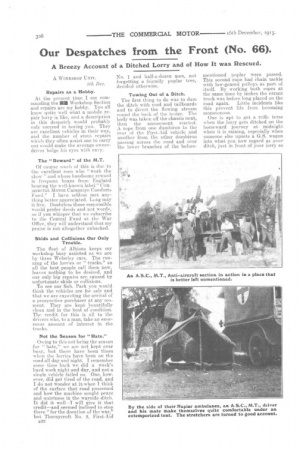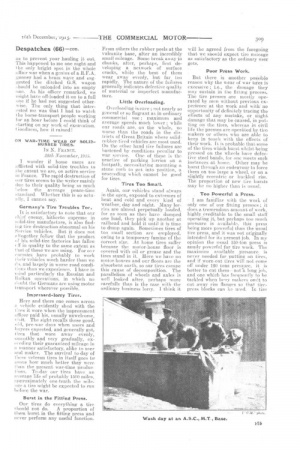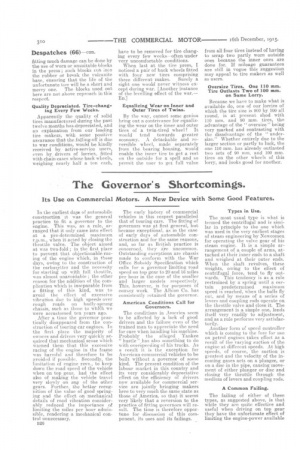Our Despatches from the Front (No. 66).
Page 4

Page 5

Page 6

If you've noticed an error in this article please click here to report it so we can fix it.
A Breezy Account of a Ditched Lorry and of How It was Rescued.
A WORKSHOP UNIT.
5th Dec.
Repairs as a Hobby. .
At the present time I am commanding the MI Workshop Section and repairs are my hobby. You all know quite well what a mobile repair lorry is like, and a description in this despatch would probably only succeed in boring you.. They are excellent vehicles in their way, and the number of stunt repairs wh;e11they often assist one to carry out would make the average ownerdriver bulge his eyes with envy.
The "Reward" of the M.T.
Of course much of this is due • to the excellent men who " work the show " and whose handsome reward is frequent boxes from England bearing the well-known label " ConBIEROT'AL MOTOR Campaign Comforts Fund." I have seldom met anything better appreciated. Long may it live. Doubtless those responsible would prefer deeds and not words, so if you whisper that we subscribe to the Central Fund at the War Office, they will understand that my praise is not altogether unbacked.
Skids and Collisions Our Only Trouble.
The fleet of Albions keeps my workshop busy assisted as we are by three Wolseley cars. The running of the lorries or "trucks," as all the best people call them now, leaves nothing to be desired, and our only big repairs are caused by unfortunate skids or collisions.
To see our Sub. Park you would think the vehicles are or sale and that we are expecting the arrival of a prospective purchaser at any moment. They are kept heautifully clean and in the best of condition. The credit for this is all to the drivers who, to a man, take an enormous amount of interest in the trucks.
Not the Season for "Hate."
Owing to this not being the season for "hate," we are not kept over busy, but there have been times when the lorries have been on the road all day and night. I remember some time back we did a week's hard work night and day, and not a single vehicle failed us. One, however, did get tired of the road, and I do not wonder at its when I think of the surface that road possessed and how the machine sought peace and quietness in the wayside ditch. It did it well—I will give it that credit—and seemed inclined to stop there "for the duration of the war," but Thornycroft No. 2, First-Aid
B22
No. 1 and half-a-dozen men, not forgetting a friendly poplar tree, decided otherwise.
Towing Out of a Ditch.
The first thing to do was to dam the ditch with mud and tailboards and to divert the flowing stream round the back of the hedge. The body was taken off the chassis next, then the amusement started. A rope from one dumbiron to the rear of the First-Aid vehicle and another from the other dumbiron passing across the road and over the lower branches of the before
mentioned poplar were passed. This second rope had ehain tackle with low-geared pulleys as part of itself. By working both ropes at the same time by inches the errant truck was before long placed on the road again. Little incidents like this prevent life from becoming monotonous.
One is apt to get a trifle terse when the lorry gets ditched on the homeward journey atmidnight when it is raining, especially when someone else upsets a G.S. wagon into what you now regard as your ditch, just in front of your lorry so
Despatches (66)—con.
as to prevent your hauling it out. This happened to me one night. and 1 he only bright spot in the whole affair was when a genius of a R.F.A. gunner had a. brain wave and suggested the ditched .G.S, wagon should be unloaded into an empty /me. As his officer remarked, we might have Off-loaded it on to a full one if he had not suggested otherwise. The only thing that interested me was that I had to watch the horse-transport people working for an hour before I could think of starting on my wink of excavation. ;oodness, how it rained!
ON WAR-TIME WEAR OF SOLID... RUBBER TIRES.
IN N. FRANCE.
28t1i November, 1915.
I wonder if home users are afflicted with solid-tire troubles to I he extent we are, on active service in France. The rapid destruction of our tires seems to the writermainly due to their quality being se much !Amy the average peace-time standard. Whether this is so actu
ally, I cannot say.• Germany's Tire Troubles Toe. It is satisfactory to note that our chief enemy, hitherto supreme in solid-tire manufacture, is also finding tire destruction abnormal on his Service vehicles. But it does not altogether follow that the product of his solid-tire factories has fallen if in quality to the same extent as t liat, of those we are using. For our Impressed-lorry Tires. Here and there one comes across a vehicle evidently shod with the t ires it wore when the impressment officer paid his, usually unwelcome, visit. The sight recalls those good, old, pre-war days when users and buyers expected, and generally got, tires that wore away evenly, smoothly and very gradually, exeredi ng their guaranteed mileage in it manner satisfactory, alike to user and maker. The survival to-day of these veteran tires in itself goes toprove how much better they were than the present war-time produc. tons. To-day our tires have an average life of probably 1500 miles,. approximately one-tenth the mileage a tire might be expected to run before the war. Burst in the Fitting Press. Our tires do everything a. tire should not do. A proportion of them burst in the fitting press and never perform any useful function. From others the rubber peels at the vulcanite base, after an incredibly small mileage. Some break away in chunks, alter, perhaps, first developing a network of surface cracks, while the best of them wear away evenly, but far too rapidly. The nature of the failures generally indicates defective quality of material or imperfect manufacture. Little Overloading. Overloading is,rrire.; not nearly so general or so flagrant as in ordinary commercial use ; maximum and average speeds much lower ; while our roads are, on the whole, no worse than the roads in the districts of Great Britain wheresolidrubber-tired vehicles are most used. On the other hand tire failures are hastened by conditions peculiar to war service. One of these is the nractiee of parking lorries on a footpath, necessitating mounting a stone curb to get into position,. a nrocee.ding which 'cannot be good for tires. . . Tires Too Small. Again, our vehicles stand .always in the open, exposed to extremes of heat and cold • and every kind of weather, day and night. Many lorries are almost perpetually loaded, for as soon as they have dumped one load, they pick up another. at railhead and hold it until it is time to dump again. Sometimes tires of too small section . are employed, owing to a temporary famine of the Correct size. At home tires suffer because the motor-house floor is covered with oil or grease and the tires stand in it. Here we have no motor-houses and our floors are the absorbent earth, so our tires escape this cause of decomposition. The parallelism of wheels and axles is well looked after, perhaps more carefully than is the case with the ordinary business lorry. I think it will be agreed from the foregoing that we should expect tire mileage as satisfactory as the ordinary user gets. Poor PI'SS Work. But there is another poSsibIe reason why the wear of war tiies is excessive; i.e., the damage they may sustain in the fitting process. The tire presses are mostly operated by men without previous experience'.at the work and with.. no opportunity of definitely tracing the effects-of any mistake, or slight damage that may be Caused, in putting on the tires, whereas in civil life the presses are operAted by tiro makers or others who are able to keep in •touch with the effectsof their work. It is probable that sonic of the tires which burst whilst being pressed on the wheels have defective steel bands, for one•meets such instances at. home. Other may be burst through an endeavour to force them on too large a wheel, or on a slightly eccentric or buckled rim. The proportion of new tire buckled, may be no higher than is usual: Too Powerful a Press. . . • I tun -familiar with the work of only one of our fitting presses ; it does .a tremendous amount of work, highly. Creditable to the small staff Operating it, but perhaps too much pressure is available, this press being more powerful than the usual tire press, and it was not originally intended for its present job. In my opinion the usual 150-ton press is amply powerful for tire work. , The maximum available pressure is never needed for putting on tires, and if worn-out tires will not come off .under 120 tons pressure, it is better. to cut them—not% long job, and one which has frequently to be tackled when lo,ry makers omit to cut away rim flanges so that tirepress blocks can be used. In tire Despatches (66)--con. fitting much damage can be done by the use of worn or unsuitable blocks in the press ; such blocks cut. into the rubber or break the vulcanite base, ensuring that the life of the unfortunate tire will be a short and merry one, The blocks used out here are not above reproach in this respect. Quality Depreciated. Tire-changing Every Few Weeks. Apparently the quality of solid tires manufactured during the past twelvemonths has depreciated, and an explanation from our leading tire makers, with some positive assurance that the falling-off is due to war conditions, would be kindly received byactive-service users even by drivers of lorries, fitted with chain eases whose back wheels, weighing nearly half a ton each, have to be removed for tire changing every few weeks—often under very uncomfortable conditions. When last at the tire press, I noticed a pair of back wheels fitted with four new tires comprising three different makes. Surely a sight one would never witness except during war, [Another instance of the-levelling effect of the war.— ED.] Equalizing Wear on Inner and Outer Tires of Twins. By the way, cannot some genius bring out a contrivance for equalizing the wear on the inner and outer tires of a twin-tired wheel ? It would tend towards . greater economy. A detachable and reversible wheel, made separately from the bearing housing, would enable the inner tireeto get a rest on the outside for a spell and so permit the user to get full value from all four tires instead of having to scrap two partly worn outside ones because the inner ones are done for. If mileage guarantees are still in vogue this suggestion may appeal to tire makers as well as users. Oversize Tires. One 110 mm. Tire Outlasts Two of 100 mm. on Same Lorry. Because we have to make what is available do, one of our lorries of which the tire size is 900 by 100 all round, is at present shod with 110 nun. and 90 mm. tires, the advantage of the "oversize" being very marked and contrasting with the disadvantage of the " undersize." Whether entirely due to the larger section or partly to luck, the one 110 min. has already outlasted two sets of 90 mm, and 100 mm. tires on the other wheels of this lorry, and looks good for another.




















